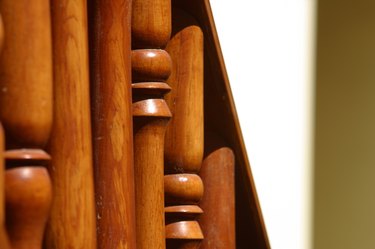Things You'll Need
Chalk line
Tape measure
Railing
Pencil
Wooden rail posts
Table saw
Drill
6-inch landscaping screws
Screw bit
Jigsaw
Wood glue
Chalk
Balusters
Router
Hex-head lag screws

A knee wall is a short wall used primarily as a partition to create rooms while maintaining an open-spaced feel, or as the side of a staircase. If the knee wall is used for a staircase, then it's common to place a rail on top of the wall for protection against falls. A wooden rail serves well as a protective support while at the same time providing an attractive addition to the stairway.
Step 1
Contact the building inspector for your area to find out the building code requirements for your new rail. These requirements will include baluster spacing as well as the height needed for your handrail.
Video of the Day
Step 2
Snap a chalk line down the center of the knee wall. Measure the distance between the ends of the knee wall that your rail will have to cover with the tape measure. Mark the measurement onto your rail with a pencil, and then cut the rail along the marked lines with a table saw. Cut the rail using a 45-degree angle on both ends from the base to the top of the rail so that you can attach the edges to the mounted posts.
Step 3
Measure the distance from the floor to the necessary height of the handrail above the knee wall at the knee wall base for the first rail post. Mark the post the measured length, measuring the post from the rail's proposed mounting position near the post top towards the base of the post. Cut off the excess base of the post beneath the measured length.
Step 4
Place the post against the knee wall with the base of the post on the floor and the post centered with the chalk line. Drill through the base of the post into the knee wall twice, about two inches upward from the floor, and about two inches down from the level of the top of the knee wall. Screw the post to the knee wall using 7-inch landscaping screws and screw bit on the drill.
Step 5
Cut a hole through the top of the knee wall where the second post needs to be installed, using a jigsaw. Make the hole just large enough to slip the post through. Measure the distance from the floor to the railing height on the post, and then cut the post to size. Slide the post through the hole until the base touches the floor and then place a bead of wood glue around the post to hold it in place.
Step 6
Lay the rail onto the knee wall in the position where you're installing it to the posts. Make a cross mark in the chalk line at the center of each stair tread with a piece of chalk and transfer the marks to the bottom of the rail.
Step 7
Cut a stair baluster for each marked line on the knee wall to the height of the bottom of the railing, plus two inches. Use a 45-degree cut along the top of the balusters so that they'll fit along the slope of the rail.
Step 8
Route a groove for the balusters with a router, 1 inch deep, and the same width as the balusters, along the bottom of the handrail running along the center of the rail.
Step 9
Attach the railing at the prescribed height between the two posts. Drill a 1-inch hole to a depth of 1/2 inch into the ends of the post where the bolts will go to hold the rail in place. Drill a second hole through the center of the posts large enough to run a hex-head lag screw through the posts and into the end of the railing. Use two mounting holes through each post for the railing. Hold the railing in place and then screw the hex-head lag screws through the post and into the railing. Cut 1-inch diameter cork plugs and place them into the post holes over the bolts.
Step 10
Cut holes in the top of the knee wall for the balusters using a jigsaw. Make the holes just large enough to snugly fit the balusters through. Wait overnight before placing any weight onto the railing.
Step 11
Slip the balusters into the hole and place wood glue onto the sloped top. Pull the top of the baluster to the routed space under the railing and press it into place against the rail surface.
Step 12
Hold the baluster in place for 30 seconds and then place a bead of glue around its base to hold it secure in the floor. Repeat the installation process for the rest of the balusters to complete the installation.
Video of the Day